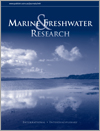Marine and Freshwater Research
Volume 74
Number 1 2023
It is important that conservation planning considers neglected taxa, supported by scientific studies. Accordingly, we critique the biology of giant ostracods, i.e. ostracods in the family Cyprididae that are ≥3 mm in length. These ostracods are common in small standing-water ecosystems, which are subject to a range of threats. We focus on the subfamily Mytilocypridinae, which consists of a diverse range of giant ostracods that are endemic to Australia and occur mainly in salt lakes, sometimes in extreme conditions.
In late 2000, western rock lobster post-larvae (puerulus) numbers declined causing fisheries management changes and investigations on why this happened, with no clear answer found. Here we use larval dispersal modelling to understand whether the oceanographic conditions at different larval stages may have contributed. We found that over the years of low settlement, a weakened northward summer current and a stronger Leeuwin Current meant that pueruli had to likely travel further and in weaker conditions to reach the nearshore areas.
Sampling the mobile fauna that use oyster reefs as habitat is difficult because of the complex nature of the reef and the often turbid conditions found within estuaries. We used acoustic imaging sonar to estimate abundance and size of fishes on fringing, intertidal oyster reefs in South Carolina, USA, and recommend a data processing protocol to standardise future studies utilising this promising, non-lethal sampling methodology.
On coastal areas, brown seaweeds provide habitat for a wide diversity of invertebrates, especially crustaceans. Within the Alboran Sea (which constitutes the entry point into the Mediterranean from the Atlantic Ocean) such associated communities show striking differences among co-existing macroalgae and according to their geographical position; species related to warmer waters become increasingly dominant towards the east. However, these small crustaceans with a key role on coastal food webs were not affected by the establishment of marine protected areas.
The New Zealand mudsnail (NZMS) (Potamopyrgus antipodarum) is a minute gastropod that has invaded several countries worldwide, which has led to it being considered as one of the most widespread invasive aquatic invertebrates in the world. In this study, we show that the highly invasive NZMS presents high variability in shell morphology and life-history traits in Chile, considering 12 populations spanning six hydrological basins, which could be favouring its ongoing expansion.
We assessed areal extent and frequency of shipping in Australian waters, and how that pattern relates to the distribution of marine parks, and satellite tracked whale sharks and baleen whales. Nearly 30% of marine parks were exposed to daily shipping effects across 100% of their area, and ∼25% of tag records of whales and whale sharks were in exposed areas.
Effects of bushfire and subsequent sediment inflows on platypus and fish abundance were investigated in the Buffalo River in north-eastern Victoria. Numbers of native two-spined blackfish and Macquarie perch dropped dramatically following post-fire siltation whereas non-native redfin perch increased. Platypus captures were consistently recorded at all survey sites both before and after fire-related disturbance, with many juveniles being recorded in the first post-fire breeding season.





